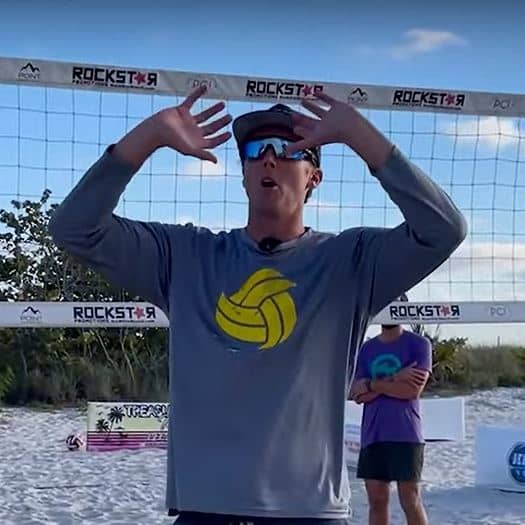
Setting in Indoor vs Beach Volleyball - 5 Big Differences
When an indoor player transitions to beach volleyball, or a beach player tries out the indoor game, it can feel like a completely different game.
One of the main reasons is the big difference in setting technique between these two types of volleyball.
If you fail to learn how hand setting works in each case, you will not be an effective setter – and you will constantly get called for violating the setting rules.
In this article you’ll learn 5 significant differences, so you can practice the perfect execution for whatever game you want to play.
Let’s dive in:
What’s different with setting in beach vs indoor volleyball?
There are big differences between indoor and beach volleyball as to how the setter approaches the ball, how strictly technique is judged regarding doubles and lifts, and how the setting motion looks as a result:
- While indoor setters play the ball lightning fast, traditional beach volleyball sets are much more about smoothly guiding the ball with a longer hand contact.
- The setting contact tends to happen very close to the net in regular volleyball, while the ball is passed further off the net in the beach game.
- Passing the first ball overhand is allowed in beach volleyball, but it is judged by the same, stricter standards as any hand set on the beach – whereas in indoor, almost anything goes when using your hands on the first ball.
- There are no special rules for setting the ball over the net in court volleyball. In beach, you have to be squared up to the target (forwards or backwards).
With the recent rise of quick plays and jump setting in beach volleyball, the outdoor setting game is getting a bit closer to indoor. But there are still obvious differences between the two sports in how the skill is executed:
1. Beach volleyball sets are contacted lower and longer
In beach volleyball, it’s fine to contact the ball at below-chin level. Pushing the ball from there means a longer contact on the ball.
As long as you don’t take the ball down with your arms and then reverse the motion, this is legal. The result is a set with mostly no spin on it – adding to the special flair of beach volleyball as a ‘clean’, stylish, and yes, somewhat elite sport.
Using this same technique in indoor volleyball will get you called for a lift violation. Prolonging the setting contact doesn’t make much sense there either, because the regular game demands a fast, versatile offense.
The way to do that is to have a quick, ‘flicky’, hard-to-read hand contact.
2. Beach players have to be careful about double contacts

The technical standards for hand setting in beach volleyball focus a lot on a clean release of the ball. Although spin in itself is not a fault, beach players are trying to set the ball with no spin, and in practice, spinning balls simply are going to be whistled more often than not.
We’ve learned that you do get to contact the ball longer in beach volleyball than indoor. On the flip side, you’ll be judged more harshly when it comes to double contacts.
Indoor sets can spin a lot and still be legal
Especially since the last few years, an indoor setter will almost never be called for a double anymore.
The officials have agreed to allow loose setting contacts, because this will speed up the game and make it even more exciting for the fans. Also, for spectators who don’t know volleyball very well, it’s not always clear why the play was stopped when the referee has called a double touch.
3. ‘Choose your technique’ vs ‘uniform style’
Beach volleyball really has no standardized technique for hand setting.
Some players take the ball higher, some lower. There are faster and slower contacts. The set can be performed as more of a full-body movement with a lot of help from the legs. It can also be almost all hands and fingers doing the work, like indoors.
These large individual differences in execution are accepted in the beach volleyball community and by referees.
Much less so in the indoor game: Setters are taught a more uniform technique, where they’re contacting the ball in a quicker motion, above their forehead, with stiffer fingers, and relatively less bend in their elbows.
4. Hand setting has always been optional in the beach game – in indoor, you absolutely need it
Many female, and some male beach volleyball players have been, and some still are, exclusively bump setting.
They see it as the safer option and they might be almost as accurate with it as players who hand set.
Indoor players only ever bump set in emergencies
In indoor volleyball this would be unthinkable. Setters are using their hands in 98% of cases – otherwise, you could not run a proper volleyball offense.
5. Tactical differences
Speaking of offensive tactics, the two types of volleyball also differ in what type of attacking plays are commonly used.
Jump setting is coming to the beach, but it’s nowhere near indoor level
Jump setting is the standard in higher-level indoor volleyball.
Up until the last few years, you would rarely see a beach player jump set. This is changing with the rise of the Swedish youngsters. More and more teams are now adding the jump setting offense to their game as well.
Still, it’s nowhere near the indoor game – where the setter will jump on almost all passes but the very worst ones.
Different sets and offensive plays
Likewise, the best beach teams have been speeding up their offense and starting to use some deceptive sets and attacking approaches.
But beach volleyball will never have the variable offense of the regular game — simply because the setter can choose between up to five attackers. This allows for so many plays that can’t be done in a doubles match.
Learn beach setting technique as an indoor player
If you’re looking to dial in your hand setting skills for the beach, I recommend you check out the article ‘Beach Volleyball Setting 101’. In it you'll start learning the proper way to set the ball in the sand, step by step.






